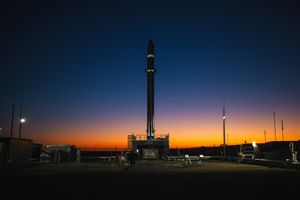
Lifting and material handling equipment company Terex (NYSE: TEX) fell short of the market’s revenue expectations in Q1 CY2025, with sales falling 4.9% year on year to $1.23 billion. On the other hand, the company’s full-year revenue guidance of $5.4 billion at the midpoint came in 2.2% above analysts’ estimates. Its GAAP profit of $0.31 per share was 28.8% below analysts’ consensus estimates.
Is now the time to buy TEX? Find out in our full research report (it’s free).
Terex (TEX) Q1 CY2025 Highlights:
- Revenue: $1.23 billion vs analyst estimates of $1.25 billion (4.9% year-on-year decline, 1.3% miss)
- EPS (GAAP): $0.31 vs analyst expectations of $0.44 (28.8% miss)
- Adjusted EBITDA: $128 million vs analyst estimates of $110.4 million (10.4% margin, 15.9% beat)
- The company reconfirmed its revenue guidance for the full year of $5.4 billion at the midpoint
- EPS (GAAP) guidance for the full year is $4.90 at the midpoint, beating analyst estimates by 15.8%
- EBITDA guidance for the full year is $660 million at the midpoint, above analyst estimates of $628.7 million
- Operating Margin: 5.6%, down from 12.2% in the same quarter last year
- Free Cash Flow was -$57 million compared to -$68.9 million in the same quarter last year
- Organic Revenue fell 18.7% year on year (4.4% in the same quarter last year)
- Market Capitalization: $3.08 billion
StockStory’s Take
Terex’s first quarter results were shaped by a combination of operational adjustments and ongoing market uncertainty. Management cited the impact of production cuts in its Aerials and Materials Processing (MP) segments, which were implemented to manage inventory and rebalance supply with demand. CEO Simon Meester highlighted that these actions impacted margins during the quarter but are now largely behind the company, with expectations for improvement in subsequent periods. The Environmental Solutions (ES) segment, particularly the recently integrated ESG business, delivered notable performance, accounting for a third of global sales and achieving high operating margins.
Looking ahead, the company’s forward guidance is influenced by its ability to mitigate tariff-related cost pressures, leverage its U.S.-centric manufacturing footprint, and realize operational synergies from the ESG acquisition. Management reaffirmed its revenue and earnings outlook for the year, pointing to strong backlog, ongoing cost controls, and a cautious approach to external uncertainties such as tariffs and macroeconomic volatility. CFO Jennifer Kong emphasized the expectation for improved free cash flow and operating margins as the year progresses, supported by continued integration benefits and operational efficiency gains.
Key Insights from Management’s Remarks
Management’s commentary focused on the operational levers and market dynamics affecting segment performance, as well as the progress of integration efforts within Environmental Solutions. Key drivers of the quarter’s financial performance included shifts in production, cost mitigation strategies, and evolving demand patterns across end markets.
- Production Cuts and Inventory Rebalancing: The Aerials and MP segments experienced reduced production volumes to align inventory with current demand, leading to under-absorption of fixed costs and temporary margin pressure. Management expects these effects to diminish, supporting margin recovery in future quarters.
- Environmental Solutions Outperformance: The ES segment, bolstered by the ESG acquisition, contributed about one-third of total sales and achieved a 19.4% operating margin. The segment benefited from record throughput and early realization of integration synergies, though management expects margins to moderate slightly in coming quarters.
- Tariff Mitigation Efforts: The company has been proactive in managing the impact of new tariffs by securing inventory early, adjusting its supply chain, and leveraging its U.S. manufacturing footprint. Approximately 75% of U.S. machine sales are sourced domestically, helping buffer the effect of trade policy shifts.
- End Market Shifts: Waste and recycling, infrastructure, and utilities now represent more than half of total revenue, making Terex less exposed to cyclical swings in general construction. Publicly funded infrastructure demand remains healthy, while private sector construction is described as cautious.
- Synergy Realization and Cost Controls: Integration of ESG is expected to deliver over $25 million in operational run-rate synergies by the end of 2026. The company also reported ongoing SG&A reductions and operational efficiency measures, which partially offset margin headwinds from volume declines.
Drivers of Future Performance
Management’s outlook for the upcoming quarters is shaped by efforts to navigate tariff-related costs, realize integration benefits, and manage demand across resilient end markets. The company’s ability to sustain margins and cash flow will depend on these ongoing initiatives.
- Tariff and Supply Chain Management: The company is focused on mitigating tariff impacts through supply chain adjustments, leveraging USMCA trade agreements, and maintaining price/cost neutrality. Management expects these actions to limit cost inflation’s effect on margins.
- ESG Integration and Synergy Capture: Continued integration of the ESG acquisition is expected to drive operational synergies, particularly in Environmental Solutions. Management anticipates these benefits will support margin improvement and segment growth over the next 18 months.
- End Market Demand and Backlog: Stable demand in waste, recycling, infrastructure, and utilities is expected to underpin revenue, while cautious private construction and European uncertainty remain risks. A strong backlog in key segments supports management’s confidence in the sales outlook.
Top Analyst Questions
- Jerry Revich (Goldman Sachs): Asked about the sustainability of ES segment margins; management attributed Q1’s strong performance to record throughput and early synergies, but expects margins to moderate as one-off benefits fade and investments ramp up.
- Jamie Cook (Truist Securities): Inquired about the effect of tariffs and whether Terex’s U.S. manufacturing provided a competitive advantage; management confirmed domestic production helps buffer tariff exposure, especially in Environmental Solutions and Aerials.
- David Raso (Evercore ISI): Sought clarity on sequential margin recovery in Aerials; management pointed to normalization of production volumes and reduced under-absorption as key drivers for expected return to double-digit margins in Q2.
- Mig Dobre (Baird): Questioned the impact of reciprocal tariffs on UK-sourced products in MP; management explained that mitigation strategies are in place, and pricing actions are considered based on segment exposure and competitive context.
- Angel Castillo (Morgan Stanley): Asked about drivers behind the improvement in MP backlog and whether it signals a bottom; management cited normalized dealer inventories and healthy North American fleet utilization, though uncertainty from tariffs remains a cautionary factor.
Catalysts in Upcoming Quarters
In the coming quarters, the StockStory team will be monitoring (1) the pace of margin recovery in the Aerials and MP segments as production normalizes, (2) the realization of operational synergies and sustained performance in Environmental Solutions following the ESG integration, and (3) the company’s effectiveness in mitigating tariff-related costs through supply chain and pricing actions. Additionally, the trajectory of backlog conversion and demand in key U.S. and international markets will serve as important indicators of execution.
Terex currently trades at a forward P/E ratio of 9.6×. At this valuation, is it a buy or sell post earnings? See for yourself in our free research report.
Our Favorite Stocks Right Now
Market indices reached historic highs following Donald Trump’s presidential victory in November 2024, but the outlook for 2025 is clouded by new trade policies that could impact business confidence and growth.
While this has caused many investors to adopt a "fearful" wait-and-see approach, we’re leaning into our best ideas that can grow regardless of the political or macroeconomic climate. Take advantage of Mr. Market by checking out our Top 5 Growth Stocks for this month. This is a curated list of our High Quality stocks that have generated a market-beating return of 176% over the last five years.
Stocks that made our list in 2020 include now familiar names such as Nvidia (+1,545% between March 2020 and March 2025) as well as under-the-radar businesses like the once-micro-cap company Kadant (+351% five-year return). Find your next big winner with StockStory today.





